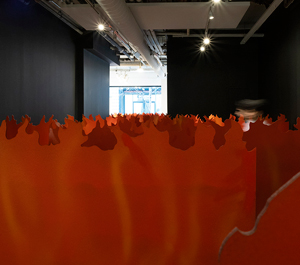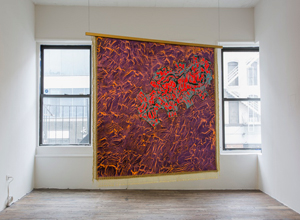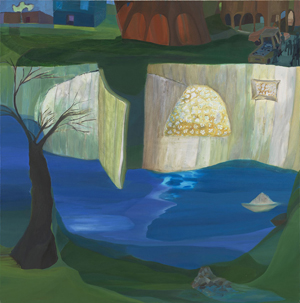A Treacherous Crossing
John Haberin New York City
Tom Pnini, Lisa Alvarado, and Ficre Ghebreyesus
The view from Orchard Street is dark, but the art within is filled with hope. They may be dashed hopes, in the face of a treacherous crossing for refugees on the high seas, but nothing seems to discourage Tom Pnini. What, too, could discourage Lisa Alvarado, who translates the harshest treatment of migrant workers into something as comforting as a blanket and gloriously close to abstraction?
Do real crossings face political obstacles more than rising waters? Both artists keep in mind a sense of present danger and an eye to the future. Pnini has his personal and family memories, too, and Alvarado gives voice in photographs to forgotten stories. She makes art about the very border regions that her subjects hope to breach. They bear in mind sweeter times, as does Ficre Ghebreyesus long since in exile. Less than polemical art can resist the powerful, too. 
A nostalgia for disaster
Darkness can also disguise a surfeit of color, but you may not know it right away. From the outside, you might think that the gallery is closed and the installation in progress. I know I did, catching a sneak peek two days before the opening. Already, though, Tom Pnini offers a warm welcome. The lights are on full blast, and what you might take for papering over the windows is a low wall, no more than shoulder high, a good ten feet past the door. It is also bright blue.
It is only the first of several partitions, staggered alternately to the left and to the right, one bluer than the next. You can hardly help weaving among them to take comfort in their color. They all have a rippling, irregular top edge, and you may as well join in their rhythm. They also hold surprises. Right past the first, you are bound to look back, to take in your surroundings, only to discover that the back of that first wall is a fiery red. As you continue past other walls, the fire only deepens.
Pnini describes them as a maze, but they have less to do with getting lost than with slowing down. The path ahead is clear enough, and so is the view to the gallery desk all the way to the back. That still leaves room for discoveries along the way. They include two portable phonographs, the kind you hardly knew they make anymore, for the two sides of an old-fashioned 45. Matching the installation's twin colors, one plays "Haul Away Joe," a sea chantey from around 1880, and the other "The Two Orphans Waltz," for the terrible aftermath of a fire. Pnini could be speaking of a Joe and a lost mother or of the two orphans when he calls the installation Two Figures in a Field.
Hannah Lee Thompson does the singing, in a voice that might sound mournful or caring, depending on your mood. It is up to visitors to reposition the needle when a song is done, so they play simultaneously now and then in call and response. One phonograph rests on a living-room sound unit from decades past, while an assemblage supplies the theater for Thompson's performance. It splits open a barrel to either side, with plenty of empty seats and with more seating above the stage at the center. As a video artist, Pnini has had similar reference points in the past, including Buster Keaton and the New England Railroad Museum. He may feel alone in a field, at sea, or in a fiery catastrophe, but he still cultivates nostalgia.
For what exactly? Ocean and fire alike refer to the immigrant experience, going back from refugees today to the flames that consumed an actual theater on the Lower East Side. Attendees, mostly immigrants, died in the stampeded to escape. Born in Israel, Pnini knows that Orchard Street tenements once housed Jewish immigrants, although only a handful of famous delis and poor excuses for clothing stores have survived gentrification and the growth of Chinatown. Better pick up that recording while you can. Copies are for sale.
So are more assemblages to one side. The artist does not quite integrate them into the show, but one can understand why he chose to build on his imagery of oceans and theaters. Two prints within the maze show a hooded silhouette in a field of red or blue. As the colors change, those ripples on the edge of each wall stand alternately for dangerous ocean waves and flames. Try to avoid a stampede on your way out, even at the opening reception. Still, nostalgia and creature comforts overwhelm darkness and disaster, and one will just have to accept a certain dancing over history as a mixed but very real blessing.
The borders of color
Critics often say that a show fills a space with color, but Lisa Alvarado makes it more than a cliché, like everything about her art. Her paintings hang from the ceiling, facing you wherever you care to step or to look. They are large enough to claim the mantle of epic abstraction, rich in red and orange touched with purple, blue, yellow, and green,—but small enough that you can see around and under them, to experience them as an installation. Her gallery always comes as a surprise, even after many visits, and a blessed relief. It opens to all sides after the climb up steep, narrow stairs, past sidewalk traffic in Chinatown. She could not fill the space more literally short of colored lights, like Doug Wheeler or Dan Flavin.
 Not that she neglects to fill the air as well. Ambient sound emerges from behind a work, framed by windows to multiply its rectangle and to hint at a world beyond. Nor does she neglect the walls either. Her photocollage looks modest enough after the hangings, but also more obviously allusive. It presents faces out of old albums, like a young man in uniform, and landscapes, bleached out but still saturated in light and water. For one last touch, a pattern out of the hangings ripples along the floor, in black, in a trail of sand by the long wall closest to the entrance.
Not that she neglects to fill the air as well. Ambient sound emerges from behind a work, framed by windows to multiply its rectangle and to hint at a world beyond. Nor does she neglect the walls either. Her photocollage looks modest enough after the hangings, but also more obviously allusive. It presents faces out of old albums, like a young man in uniform, and landscapes, bleached out but still saturated in light and water. For one last touch, a pattern out of the hangings ripples along the floor, in black, in a trail of sand by the long wall closest to the entrance.
Alvarado has drawn her line in the sand and then crossed it, repeatedly. She works in acrylic on fabric, not weaving, but its threads unravel along three sides. You may want to wrap yourself within it, like a blanket, much like her figurative blanket of color. The patterns suggest tapestry as well, in zigzags with room for curves like the ones in sand. Both stop just short of regularity and short of the edges. That leaves bright, solid borders that every so often take over more of the painting, as full-blown color fields.
This artist is into borders. She describes her subject as "transitional spaces," although she seems just as much to relish breaking out of them. Tapestries, like those of Mary Lee Bendolph and Gee's Bend quilting, often display off the wall, although not this far off. Could Alvarado have another motive as well? Sure enough, she invites you to walk around and between them, to discover another mark on the back. It does not take up that much of the surface, but rather compresses the larger patterns into a kind of signature.
It hints, too, at a mass-market alternative to hand quilting or to her painting. One can imagine her leaving it on the back, where one will never see it, as directions to factory production on the front. The resultant medium is more confusing than ever, and the references keep piling up. Abstraction, weaving, sound art, earth art, and those faces—they belong collectively to New York arts, the South, "women's work," people of color, and America's own borders. Alvarado relates them to an earlier round of mass deportations, the Mexican repatriation of the 1930s. Donald J. Trump can only aspire to crush half so many immigrant and citizen dreams.
Not everything coheres, and you may not guess at more than a fraction of the references, but she has one yet to come, from another continent and another century. She titles the paintings and the show Thalweg, a modern word from what I presume is Middle English (in which "weg" means way). It means a border that follows the course of a riverbed at its lowest point. The laws of nature are asserting themselves, just when politics and people keep getting in the way. She also subtitles the paintings Traditional Object, but what tradition would that be? Call it living on border lines.
Two boats
Ficre Ghebreyesus was one of the lucky ones, a refugee who found a longtime home. He could cherish his freedom, after a long and difficult passage, and his painting. He could cherish, too, his memories. They carried him across oceans, and his gallery calls a large show "Gate to the Blue." Was he ever torn between what he had found and what he had left behind? One could almost call the show a tale of two boats.
The gate in Gate to the Compound is open, but the barriers are formidable all the same. Tall white walls separate the compound from the sea, with only a bare tree and a mysterious object, perhaps a blanket or a body, on the opposite shore. Sunlight ripples across the bright blue sea at the painting's center, bridging land to land. The compound has arched gateways of its own, in a fiery red, but not a sign of life. Still, the white walls curve gently across four feet of canvas and along the water, touched by gradations of orange and green. They convey melancholy, but also a welcome silence.
A boat crosses the darkest corner of the sea, so small that it might be child's toy and so still that it might be at rest. It seems far in spirit from another boat, in a second painting with no room for quiet. Bodies there lie everywhere, on the sails or pitched into rough seas. Their schematic form, like stick figures but curvy, attests to a loss of humanity. Still, the painter seems once again at peace. The bodies almost match patterned wallpaper in an interior by Henri Matisse.
Turbulent waters are a staple in art, from shivering soldiers crossing the Delaware for Jacob Lawrence to the refugee crisis today. And boats may seem only natural for a native of Eritrea, a culturally diverse nation on the Red Sea.  Born during a horrendous civil war and growing up in a dictatorship, Ghebreyesus became an activist on behalf of relief measures and human rights. The smaller painting, the size of legal paper, attests not to helplessness but to taking charge. It depicts the Amistad, the slave ship from East Africa and site of a successful uprising in 1839. He inscribes the painting's date on the ship's hull, below its name, as if the artist's signature could extend to both.
Born during a horrendous civil war and growing up in a dictatorship, Ghebreyesus became an activist on behalf of relief measures and human rights. The smaller painting, the size of legal paper, attests not to helplessness but to taking charge. It depicts the Amistad, the slave ship from East Africa and site of a successful uprising in 1839. He inscribes the painting's date on the ship's hull, below its name, as if the artist's signature could extend to both.
In real life, he escaped by land into Sudan, the homeland of Ibrahim El-Salahi, before stops in Europe and finally America. He remained in New Haven, where he opened a café, from his Yale MFA until his death in 2002, at age fifty. If he kept up a dual or even triple life in his activism, his cooking, and his art, the African diaspora, and African famliy histories fed them all. Still, he conveys most a lost and found peace. He was good at leaving things behind, including his anger. His acrylic colors are muted, almost like tempera or like childhood memory itself.
Ghebreyesus remembers shy faces, often women, and musicians, as if they were still singing only to him. He remembers a boy, perhaps himself as a boy, walking with his nose in a book. He remembers a bird, maybe a dove as another token of inner peace. Memories can be vivid, too, of course, and his colors add up, in broad areas and in patchwork akin to Cubism or stained glass. In his largest painting, more than seven feet in length, they approach gilding. It is unstretched canvas, like raw scraps of memory or fabric from his native land, but it represents still another gate or wall. Look close, though, and there is a welcoming knob on the door.

Tom Pnini ran at Lesley Heller through February 22, 2020, Lisa Alvarado at Bridget Donahue through August 30, and Ficre Ghebreyesus at Galerie Lelong through October 24.




